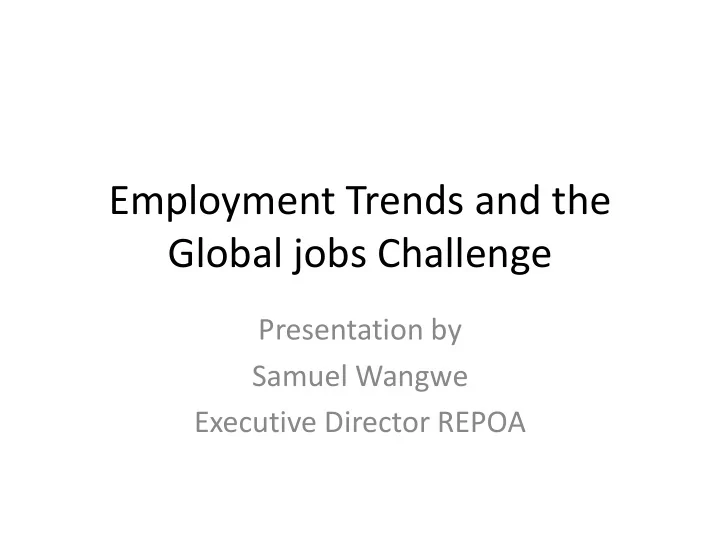

Employment Trends and the Global jobs Challenge Presentation by Samuel Wangwe Executive Director REPOA
Global Financial Crisis and Global Trends • Impact: growth, employment and poverty – Slowed growth of GDP and incomes – Budgets under stress as revenues fell – Loss of jobs – Stress on social protection – Income poverty on the rise – human development indicators deteriorated
Global Financial Crisis and Global Trends-2 • The world enters the year 2012 facing a serious jobs challenge and widespread decent work deficits- backlog of global unemployment of 200 million – an increase of 27 million since the start of the crisis. • To generate sustainable growth while maintaining social cohesion, the world must rise to the urgent challenge of creating 600 million productive jobs over the next decade, • Even this would still leave 900 million workers living with their families below the US$2 a day poverty line, largely in developing countries .
Global Financial Crisis and Global Trends-3 • The most pressing challenges are the continued jobs is the declining prospects for economic growth. Output growth has already slowed considerably during 2011, especially in the developed countries. • Unemployment remains high, at nearly 9 per cent (global youth unemployment rate, at 12.7 per cent); • As incomes stagnate, lack of aggregate demand is likely to stall recovery even further.
Global Financial Crisis and Global Trends-4 • Recent events in well performing countries in the Arab world and others suggest that economic growth, rising fiscal resources and improvements in education have to be complemented by promotion of employment and social cohesion.
MDGs: Status and prospects • MDG1 has been enhanced to include full and productive employment and decent work for all. Four indicators of employment have been developed: – labour productivity growth (GDP per person employed) – employment- population (working-age) ratio – working poverty rate – vulnerable employment rate i.e. own account workers and unpaid family workers as a proportion of the working population.
MDGs: Status and prospects-2 • Growth-poverty: the key channel is employment • Most people in Africa are employed somehow but they are poor- the working poor • Raising labour productivity lies at the heart of the reduction of decent work deficits and is intrinsically relate to overall development. • Analysis of labour productivity measures at various levels (micro, sectoral and total economy) is an essential part of the development strategy.
Socioeconomic Transformation for Growth and Employment • poverty and the employment challenge are best addressed through broad economic progress • Case for revisiting the debate on reshaping the development agenda to address socioeconomic transformation for poverty reduction through employment creation (formal and informal).
Socioeconomic Transformation for Growth and Employment -2 • to enhance productive capacity • promote quality of jobs (centrality of productivity) • improve the composition of outputs (shifting towards knowledge products and services for higher productivity) • facilitate equitable poverty reduction.
Socioeconomic Transformation for Growth and Employment -3 • Macroeconomic Policies for Job-rich Growth – On the demand side, the focus is on the influence on aggregate demand including demand of goods consumed by the poor- to limit damaging impacts on the income of the poor, – On the supply side, focus on influencing the capacity to supply including the supply capacity of MSMEs in the sectors in which the poor are active.
Socioeconomic Transformation for Growth and Employment-4 • Macroeconomic Policies for Job-rich Growth – Rethinking development cooperation policy to be guided by policy coherence: • global governance in policy management • broaden and deepen recent G-20 initiative of sharing of stimulus package; • Greater developing country participation in OECD discussions of policy coherence to promote consistency with the Paris declaration principles
Agricultural and Rural Transformation • Potential for agricultural and rural transformation • MSME transformation – increasing agricultural and non-agricultural rural productivity as well as productivity in rural non-farm activities. • Investing in capabilities for farms and firms to be competitive and continue to create employment in the competitive environment. – enhanced agricultural links to non-agricultural activities • Investing in the development of linkages to the industrial and service sectors to achieve structural transformation that stimulates growth, creates employment and reduces poverty.
Potential of SMEs for job-rich growth • According to a recent report by Christian Rammer. Small and Medium Sized Companies which serve the domestic market SMEs have performed well in weathering the global economic recession and financial crisis (ZEW News, 2009). • This outcome has been facilitated by labour market measures, unchanged consumer sentiment and demand for their products and services being boosted by the government’s stimulus package. • However, the successful SMEs have been those with solid financing and business strategies with a long term focus.
Transforming MSM Enterprises in the Informal Economy • Transforming enterprises including those in the informal economy to: – enable access to key resources such as finance, business premises and quality human resources, – provide gainful and decent work through productivity increase,
Issues for discussion Beyond MDGs to socioeconomic transformation for growth and employment: three issues of concern. 1. Poverty and employment challenge is best addressed through rethinking the development agenda – towards socioeconomic transformation (agricultural and rural transformation and transformation of MSMEs in the informal economy) 2. Macroeconomic policies for growth and employment- demand and supply side and policy coherence 3. Employment challenge as a productivity and vulnerability challenge;
Recommend
More recommend